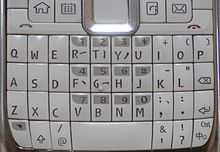Wubihua method

The 'Wubihua method, Stroke input method or Bihua IME (Chinese: 五笔画输入法; pinyin: wǔ bǐhuà shūrù fǎ or Chinese: 筆劃輸入法; pinyin: Bǐhuà shūrù fǎ) (lit. 5-stroke input method) is a relatively simple Chinese input method for writing text on a computer or a mobile phone. It is based on the stroke order of a word, not pronunciation.[1] It uses five or six buttons, and is often placed on a numerical keypad. Although it is possible to input Traditional Chinese characters with this method, this method is often associated with Simplified Chinese characters. The Wubihua method should not be confused with the Wubi method.
Each of the five keys from 1 to 5 are assigned a certain type of stroke (resembling the Eight Principles of Yong): 1 for horizontal strokes (一), 2 for vertical strokes (丨), 3 for downwards right-to-left strokes (丿), 4 for dot strokes or downwards left-to-right strokes (丶), and 5 for all other strokes (marked 乛 or 乙). To input any character, the user simply presses the keys corresponding to the first four strokes of a character and the key corresponding to the last stroke of a character. The user presses * or 0 after the last stroke for characters with four strokes or less. Some Wubihua systems have a match option that the user presses to indicate the code is complete. Some systems take more than 4 strokes.
The user must select from a list of matching characters. The list of suggestions to choose from becomes more and more specific as more digits of the code are entered.[1] The system will not recognize a character input with an incorrect stroke order.[1]
Wubihua is one of the easiest to learn methods because it is simple and does not require knowledge of pronunciation or Pinyin. However, it tends to be vague, as a Wubihua code will normally match ten characters, and each character has one correct code, which confuses users whose stroke orders are wrong.
Strokes map to Wubihua input generally according to the following table:
| Wubihua Character | Stroke Type | Stroke | Examples (simplified Chinese and pinyin) |
|---|---|---|---|
| 1 | Horizontal, or Rising | |
横 Héng |
| |
提 Tí | ||
| 2 | Vertical | |
竖 Shù |
| |
竖钩 Shù Gōu | ||
| 3 | Falling to the Left | |
撇 Piě |
| |
撇钩 Piě Gōu | ||
| 4 | Dot, or Falling to the Right | |
点 Diǎn |
| |
捺 Nà | ||
| |
提 捺 Tí Nà | ||
| 5 | Turning | |
横折 Héng Zhé |
| |
横撇 Héng Piě | ||
| |
横钩 Héng Gōu | ||
| |
竖折 Shù Zhé | ||
| |
竖弯 Shù Wān | ||
| |
竖提 Shù Tí | ||
| |
撇横 Piě Zhé | ||
| |
撇点 Piě Diǎn | ||
| |
撇钩 Piě Gōu | ||
| |
弯钩 Wān Gōu | ||
| |
斜钩 Xié Gōu | ||
| |
横折折 Héng Zhé Zhé | ||
| |
横折弯 Héng Zhé Wān | ||
| |
横折提 Héng Zhé Tí | ||
| |
横折钩 Héng Zhé Gōu | ||
| |
横斜钩 Héng Xié Gōu | ||
| |
竖折折 Shù Zhé Zhé | ||
| |
竖折撇 Shù Zhé Piě | ||
| |
竖弯钩 Shù Wān Gōu | ||
| |
横折折折 Héng Zhé Zhé Zhé | ||
| |
横折折撇 Héng Zhé Zhé Piě | ||
| |
横折弯钩 Héng Zhé Wān Gōu | ||
| |
横撇弯钩 Héng Piě Wān Gōu | ||
| |
竖折折钩 Shù Zhé Zhé Gōu | ||
| |
横折折折钩 Héng Zhé Zhé Zhé Gōu |
See also
References
- ↑ 1.0 1.1 1.2 Wicentowski, Joe (1994). "Wubihua for Speakers of English". Yale University. Retrieved 10 October 2013.